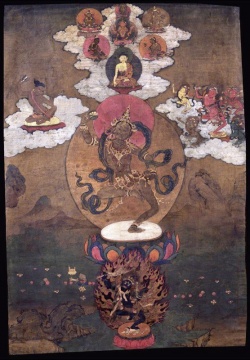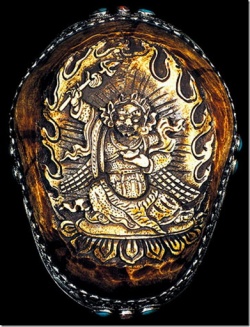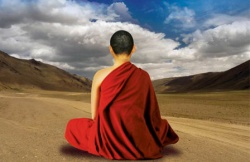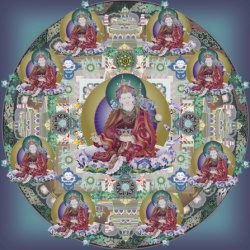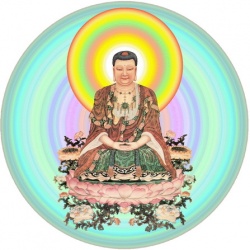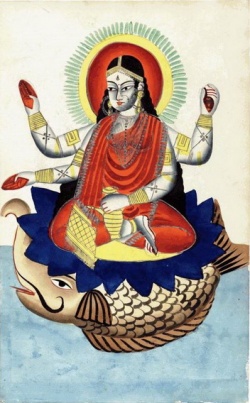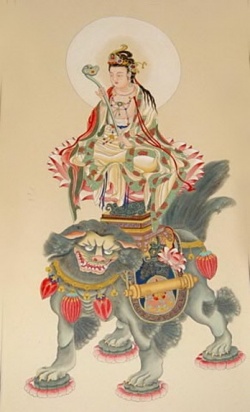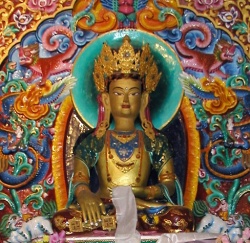Buddhism: the Historical Context of the Doctrine of Awakening
(from "The Doctrine of Awakening")
First, a word about method. From the "traditional" point of view that we follow in this work, the great historical traditions are to be considered neither as "original" nor as arbitrary. In every tradition worthy of the name, elements are always present, in one form or another, of a "knowledge" that, being rooted in a superindividual reality, is objective. Furthermore, each tradition contains its own special mode of interpretation and cannot be considered as arbitrary or as proceeding from extrinsic or purely human factors. This particular element tends to vary with the prevailing historical and spiritual climate; and we can find in it the reason for the existence of certain formulations, adaptations, or limitations of the one knowledge—and the nonexistence of others. No one individual, suddenly, and as if inspired haphazardly by some outside agency, ever proclaimed the theory of the atma, for example, or invented nirvana or the Islamic theories. On the contrary, all traditions or doctrines obey, even without seeming to do so, a profound logic—discoverable by means of an adequate metaphysical interpretation of history. Accordingly, this shall be our standpoint when we deal with these aspects of Buddhism: this is also why we consider that critic to be fundamentally mistaken who tries at all costs to pin the label "original" on Buddhism or, indeed, on any great tradition, and who argues that "otherwise" such a tradition would in no way differ from others. A difference there is, as there is also an element in common with what has gone before; but both are determined—as we have said— by objective reasons, even though they may not always have been seen clearly by the individual exponents of particular historical trends.
Having said this, we must go back to the pre-Buddhist Indo-Aryan traditions in order to find the precise implications of the Buddhist doctrine, and in them we must distinguish between two fundamental phases: the Vedic and the Brahmana Upanisad.
With regard to the Vedas, which constitute the essential foundation of the entire tradition in question, it would not be correct to talk either of "religion" or of "philosophy." To begin with, the term veda—from the root vid, which is equivalent to the Greek ... (whence we have, for example, ...) and which means "I see," "I have seen"—refers to a doctrine based not on faith or "revelation," but on a higher knowledge attained through a process of seeing. The Vedas were "seen": they were seen by the rshi, by the "seers" of the earliest times. Throughout the tradition their essence has never been regarded as a "faith" but rather as a "sacred science."
Thus it is frivolous to see in the Vedas, as many people do, the expression of a "purely naturalistic religion." As in other great systems, impurities may be present particularly where foreign matter has crept in, and very noticeably, for example, in the Atharva Veda. But what the essential and most ancient part of the Vedas reflects is a cosmic stage of the Indo-Aryan spirit. It is not a question of theories or of theologies, but of hymns containing a magnificent reflection of a consciousness that is still so harnessed to the cosmos and to metaphysical reality that the various "gods" of the Vedas are more than religious images; they are projections of the experience of significances and forces directly perceived in man, in nature, or beyond through a cosmic, heroic, and "sacrificial" concept, freely and almost "triumphantly."
Although they were written considerably later, the fundamental thought contained in such epic poems as the Mahabharata goes back to the same epoch. Men, heroes, and divine figures appear side by side; and as Kerényi said when referring to the Olympian-Homeric phase of the Aryo-Hellenic tradition, men could "see the gods and be seen by them," and could "stand with them in the original state of existence." The Olympian element is reflected also in a typical group of Vedic divinities: in Dyaus (from div, "to shine"—a root that is also found in Zeus and Deus), for example, lord of the heavenly light, the origin of splendor, strength, and knowledge; in Varuna, also a symbol of celestial and regal power, and connected with the idea of rta, that is to say, of the cosmos, of a cosmic order, of a natural and supernatural law; while in Mitra there is, in addition, the idea of a god of the specifically Aryan virtues, truth and fidelity. We also have Surya, the flaming sun from whom, as from the Olympian , nothing is hidden, who destroys every infirmity and who, in the form of Savitar, is the light that is exalted in the first daily rite of all the Aryan castes as the principle of awakening and intellectual animation; or there is Usas, the dawn, eternally young, who opens the way for the sun, who gives life and who is the "token of immortality." In Indra we find the incarnation of the heroic and metaphysical impulse of the first Hyperborean conquerors: Indra is "he, without whom men cannot win," he is the "son of force," the lightning god of war, valor, and victory, the annihilator of the enemies of the Aryans, of the black Dasyu, and, consequently, of all the tortuous and titanic forces that "attempt to climb the heavens"; while at the same time he appears as the consolidator, as "he who has consolidated the world." The same spirit is reflected, in varying degrees, in minor Vedic divinities, even in those tied to the most conditioned forms of existence.
In the Vedas we find that this cosmic experience is evoked through the agency of sacrificial action. The sacrifice rite extends human experience into the non-human, and provokes and establishes communion between the two worlds in such a manner that the sacrificer, a figure as austere and majestic as the Roman flamen dialis, assumes the traits of a god on earth (bhu-deva, bhu-sura). As for life after death, the Vedic solution is fully consonant with the oldest Aryo-Hellenic spirit: images of obscure hells are almost entirely absent from the most ancient parts of the Vedas: the crisis of death is hardly noticed as such—in the Atharva Veda it is even considered as the effect of a hostile and demoniacal force that, with suitable rites, can be repulsed. The dead pass into an existence of splendor that is also a "return," and in which they once again take up their form: "Having laid aside all defects, return home: full of splendour unite thyself to [thy] form"—and again: "We drank the soma (symbol of a sacred enthusiasm), we became immortal, we reached the light." The symbolic Vedic rite of "wiping out the tracks," so that the dead will not return among the living, well shows how the idea of reincarnation was almost totally absent in this period; such a possibility was ignored in the light of the high degree of heroical, sacrificial, and metaphysical tension belonging to that epoch. There is no trace in the Vedas of the later significance of Yama as god of death and hell; rather, he retains the outlines of his Irano-Aryan equivalent, Yima, sun king of the primordial age: son of the "Sun." Yama is the first of the mortals and he "who first found the road [to the hereafter]": thus, broadly speaking, the Vedic "hereafter" is bound up in great measure with the idea of a reintegration of the primordial state.
About the tenth century b.c. new developments began: they found expression in the Brahmana texts on the one hand, and on the other in the Upanisad texts. Both go back to the tradition of the Vedas: yet there is a noteworthy change of perspective. We are slowly approaching "philosophy" and "theology."
The speculation of the Brahmana texts rests chiefly on that part of the Vedas that refers to ritual and sacrificial action. Ritual, in all the traditional civilizations, was conceived neither as an empty ceremony nor as a sentimental and, at the same time, formal act of praising and supplicating a God, but rather as an operation with real effects, as a process capable not only of establishing contacts with the transcendent world, but of imposing itself upon supersensible forces and, through their mediation, eventually influencing even the natural forces. As such, ritual presupposes not only knowledge of certain laws, but also, and more essentially, the existence of a power. The term brahman (in the neuter, not to be confused with Brahma in the masculine, which designates the theistically conceived divinity) originally signified this particular energy, this kind of magic power, this fluid or life force, upon which the ritual rests.
In the Brahmana texts this ritual aspect of the Vedic tradition was enlarged and formalized. Ritual became the center of everything and the object of a fastidious science that often became a formalism destitute of any vital content. Oldenberg, referring to the period of Prince Siddhattha, talks in this connection of "an idiotic science knows everything and explains everything, and sits enthroned, satisfied, amongst its extravagant creations." This judgment is excessive, but it is not entirely unjustified. In the Buddha's time there existed a caste of theologi philosophantes who administered the remnants of the ancient tradition, trying with all the means in their power to establish a prestige that did not always correspond to their human qualifications or to their race—if not their physical race, which was well cared for by the caste system, at least their spiritual race. We have used the word "theologists" since the concept of brahman in these circles gradually became generalized and, in a manner of speaking, substantialized, to such an extent that the brahman finally no longer signified the mysterious force that, fundamentally, only made sense in terms of ritual and magic experience; it came to mean the soul of the world, the supreme force-substance of the universe, the substratum, indeterminate in itself, of every being and of every phenomenon. It thus became an almost theological concept.
The Upanisads, on the other hand, concentrated mainly on the doctrine of the atma. which largely reflected the original cosmic and solar sentiment of the earliest Aryan consciousness, insofar as it stressed the reality of the "I" as the superindividual. unchanging, and immortal principle of the personality, as opposed to the multiple variety of the phenomena and forces of nature. The atma is defined by neti neti ("not so, not so"), that is to say, by the idea that it does not belong to nature or, more generally, to the conditioned world.
In India the speculative current of the Brahmana and that of the Upanisads gradually converged; this convergence resulted in the identification of the brahman with the atma: the "I," in its superindividual aspect, and the force-substance of the cosmos became one and the same thing. This was a turning point of the greatest importance in the spiritual history of the Indo-Aryan civilization. The doctrine of the identity of the atma with the brahman did, in fact, constitute a metaphysical achievement but, at the same time, it initiated a process of breaking up and of spiritual dissolution. This process was bound to take place as shadows began to cloud the luminosity of the original heroic and cosmic experience of Vedic man and as foreign influences gained ground. Originally the doctrine of the Upanisads was considered as "secret," as a knowledge to be transmitted only to the few—the term Upanisad itself conveyed this idea. But in point of fact the philosophical and speculative tendencies became uppermost. This resulted in divergencies of opinion even in the oldest Upanisad—the Chandogya—and the Brhadaranyaka Upanisad—as to the plane of consciousness to be used as the reference point for the doctrine. Is the atma object of immediate experience or is it not? It is both one and the other at the same time. Its substantial identity with the "I" of the individual is affirmed but, at the same time, we often see the unity of the individual with the atma-brahman postponed till after death; and not only this, but conditions are postulated under which it will happen, and the case is considered in which the "I," or rather the elements of the person, may not leave the cycle of finite and mortal existences. In the ancient Upanisads, in fact, no precise solution is ever reached of the problem of the actual relationship existing between the individual "I" of which everyone can talk, and the atma-brahman. We do not consider that this was accidental: it was a circumstance that corresponded to an already uncertain state of consciousness, to the fact that, while for the adepts of the "secret doctrine" the "I" could be equated effectively with the atma, for the general consciousness the atma was becoming a simple speculative concept, an almost theological assumption, since the original spiritual level was beginning to be lost.
Furthermore, the danger of pantheistic confusions showed itself. This danger did not exist in theory since, in the Upanisads, following the Vedic concept, the supreme principle was not only conceived as the substance of the world and of all beings, but also as that which transcends them "by three quarters," existing as "the immortal in the heavens." In the same Upanisads, however, prominence is also given to the identity of the atma-brahman with elements of all kinds in the naturalistic world, so that the practical possibility of a pantheistic deviation encouraged by the assimilation of the atma with the brahman was real: particularly so, if we take into account the process of man's gradual regression, of which we can find evidence in the teaching of all traditions, including the Indo-Aryan, where the theory of the four yuga corresponds exactly to the classical theory of the four ages and of man's descent to the last of them, the Iron Age, equivalent to the "Dark Age" (kali-yuga) of the Indo-Aryans. If, during the period of these speculations, the original cosmic and uranic consciousness of the Vedic origins had already suffered in this way a certain overclouding, then the formulation of the theory of the identity of the atma with the brahman provided a dangerous incentive toward evasion, toward a confused self-identification with the spirituality of everything, at the very moment when a particularly energetic reaction by way of a tendency toward concentration, detachment, and awakening was needed.
Altogether, the germs of decadence, which were already showing themselves in the post-Vedic period and which were to become quite evident in the Buddha's day (sixth century b.c.), are as follows: above all, a stereotyped ritualism; then the demon of speculation, whose effect was that what ought to have remained "secret doctrine," upanisad, rahasya, became partly rationalized, with the result that there eventually appeared a tumultuous crowd of divergent theories, sects, and schools, which the Buddhist texts often vividly describe. In the third place, we find a "religious" transformation of many divinities who, in the Vedic period were, as we have said, simply cosmically transfigured states of consciousness; these have now become objects of popular cults. (1) We have already spoken of the pantheistic danger. In addition to these points we have yet to consider the effect of foreign, non-Aryan influences, to which we believe are attributable in no small degree the formation and diffusion of the theory of reincarnation.
(1) It is essentially of these gods that we must think when we see them assume, in Buddhist texts, quite modest and subordinate parts, transforming themselves sometimes almost into quasi disciples who receive revelation of the doctrine from the Buddha. We are dealing, that is, with the degradation of the ancient gods: and the doctrine revealed by the Awakened One corresponds, basically, with what they once signified, but which at this period, had been forgotten.
As we have said, there is no trace of this theory in the early Vedic period; this is because it is quite incompatible with an Olympian and heroic vision of the world, being as it is a "truth" of non-Aryan races that are tellurically and matriarchally adjusted in outlook. Reincarnation, in fact, is conceivable only by one who feels himself to be a "son of the earth," who has no knowledge of a reality transcending the naturalistic order; bound as he is to a female-maternal divinity found alike in the pre-Aryan Mediterranean world, and in the pre-Aryan Hindu civilization, such as the Dravidian and Kosalian. Into the source from which as an ephemeral being he has sprung, the individual, when he dies, must return, only to reappear in fresh terrestrial births, in an inescapable and interminable cycle. This is the ultimate sense of the theory of reincarnation, a theory that begins to infiltrate as early as the period of Upanisad speculations; it gives place gradually to mixed forms that we can use as a measure of the change in the original Aryan consciousness to which we have referred.
While in the Vedas only a single fate after death is considered, as in ancient Hellas, in the Brahmana texts the theory of the double way already appears: "[Only] he who knows and practices ritual action rises again in life and obtains immortal life; the others who neither know nor practice ritual action will continue to be born anew, as nourishment for death." In the Upanisads, however, as the relationship between the real "I" and the atma oscillates, so does their teaching of what happens after death. They speak of the "dyke, beyond which even night becomes day, since the world of the brahman is unchangeable light"; a dyke constituted by the atma against which neither decay, nor death, nor pain, nor good action, nor bad action can prevail." They speak of the "way of the gods" (deva-yana) that leads one after death to the unconditioned whence "there is no return." But at the same time another road is considered, the pitr-yana, along which "one returns," the individual after death being little by little "sacrificed" to various divinities for whom he becomes "food," finally to reappear on the earth. In the oldest texts the possibility of a liberation is not considered for those who go on this second road: they speak instead of the "causal law," of the karma, which determines a man's subsequent existence on the basis of what he has done in the preceding one. We have now arrived at what we shall call the samsaric consciousness (from samsara), which is the keystone of the Buddhist vision of life: the secret knowledge, confided privately by the wise Yajnavalkya to the king Artabhaga, is that after death the individual elements of man dissolve in the corresponding cosmic elements, including the atma, which returns to the "ether," and that which is left is only the karma, that is, the action, the impersonal force, bound to the life of one being, that will go on to determine a new being.
In all this can be seen, then, more than just the effect of "free" metaphysical speculation: it is, rather, a sign of a consciousness that begins to consider itself terrestrial or, at the most, pantheistically cosmic, and that now centers itself on that part of the human being that may really be concerned with death and rebirth and indefinite wandering across various forms of conditioned existence; we say "various" since the horizons gradually widened and it was even thought that one might re-arise in this or that world of gods, according to one's actions. In any case, in the epoch in which Buddhism appeared the theories of reincarnation and of transmigration were already an integral part of the ideas acquired by the predominant mentality. Sometimes, and even in the Upanisads, different outlooks became indiscriminately combined so that on the one side was conceived an atma that, although divorced from any concrete experience, was supposed to be permanently and intangibly present in everyone, and on the other side there was the interminable wandering of man in various lives.
It is on these lines that practical and realistic currents gradually established themselves in opposition to the speculative currents. We can include Samkhya, which opposed to the pantheistic danger a rigid dualism and in which the reality of the "I" or atma—called here purusa—as the supernatural, intangible, and unalterable principle is opposed to all the forms, forces, and phenomena of a natural and material order. But more important in this respect are the trends of yoga. Based both on Samkhya and on ascetic tendencies already coming to the fore in opposition to ritualistic and speculative Brahmanism, these recognized more or less explicitly the new state of affairs, which was that in speaking of "I" one could no longer concretely understand the atma, the unconditioned principle; that it appeared no longer as direct consciousness; and that therefore, apart from speculation, it could only be considered as an end, as the limit of a process of reintegration with action as its basis. As the immediate real datum there was substituted instead what we call "samsaric" consciousness and existence, consciousness bound to the "current"—and the term samsara (which thus only makes a relatively late appearance) means precisely "current"—it is the current of becoming.
It is not out of place to consider another point. The brahmana caste is habitually thought of in the West as a "sacerdotal" caste. This is true only up to a certain point. In the Vedic origins the type of Brahman or "sacrificer" bears little resemblance to that of the "priest" as our contemporaries think of him: he was, rather, a figure both virile and awful and, as we have said, a kind of visible incarnation in the human world of the superhuman (bhu-deva). Furthermore, we often find in the early texts a point where the distinction between the brahman—the "sacerdotal" caste—and the ksatram or rajam—the warrior or regal caste—did not exist; a feature that we see in the earliest stages of all traditional civilizations, including the Greek, Roman, and German. The two types only began to differ in a later period, this being another aspect of the process of regression that we have mentioned. Besides, there are many who maintain that in Aryan India the doctrine of the atma was originally confined almost exclusively to the warrior caste, and that the doctrine of brahman as an undifferentiated cosmic force was formulated mainly by the sacerdotal caste. There is probably some truth in this view. In any case, it is a fact that in many texts we see a king or a ksatriya (a member of the warrior nobility) vying in knowledge with and sometimes even instructing members of the Brahman caste; and that, according to tradition, primordial knowledge was handed down, starting from Iksvaku, in regal succession; the same "solar dynasty" (surya-varhsa) that we mentioned in connection with the Buddha's family, also figures here. We should have the following picture: in the Indo-Aryan post-Vedic world, while the warrior caste held a more realistic and virile view and put emphasis on the doctrine of the atma as the unchangeable and immortal principle of human personality, the Brahman caste was becoming little by little, "sacerdotal" and, instead of facing the reality, was moving among ritual and stereotyped exegeses and speculations. Simultaneously, in another way, the character of the first Vedic period was becoming overgrown with a tropical and chaotic vegetation of myths and popular religious images, even of semidevotional practices seeking the attainment of this, that, or the other divine "rebirth" on the basis of views on reincarnation and transmigration that, as we have said, had already infiltrated into the less illuminated Indo-Aryan mentalities. Leaving yoga apart, it is worth noting that it was the warrior nobility—the ksatram—that furnished the principal support not only of the Sarhkhya system, which is regarded as representing a clear reaction against speculative "idealism," but also of Jainism, the so-called doctrine of the conquerors (from jina, "conqueror"), which laid emphasis, though with a tendency to extremism, on necessity for ascetic action.
All this is necessary for our understanding of the historical place of Buddhism and of the reasons of its most characteristic views.
From the point of view of universal history, Buddhism arose in a period marked by a crisis running through a whole series of traditional civilizations. This crisis sometimes resolved itself positively thanks to opportune reforms and revisions, and sometimes negatively with the effect of inducing further phases of regression or spiritual decadence. This period, called by some the "climacteric" of civilization, falls approximately between the eighth and the fifth centuries b.c. It is in this period that the doctrines of Lao-tzu and Kung Fu-tzu (Confucius) were taking root in China, representing a renewal of elements of the most ancient tradition on the metaphysical plane on the one hand, and on the ethical-social on the other. In the same period it is said that "Zarathustra" appeared, through whom a similar return took place in the Persian tradition. And in India the same function was performed by Buddhism, also representing a reaction and, at the same time, a re-elevation. On the other hand, as we have often pointed out elsewhere, it seems that in the West processes of decadence mainly prevailed. The period of which we are now talking is, in fact, that in which the ancient aristocratic and hieratic Hellas declined; in which the religion of Isis along with other popular and spurious forms of mysticism superseded the solar and regal Egyptian civilization; it is that in which Israelite prophetism started the most dangerous ferments of corruption and subversion in the Mediterranean world. The only positive counterpart in the West seems in fact to have been Rome, which was born in that period and which for a certain cycle was a creation of universal importance, animated in high measure by an Olympian and heroic spirit.
Coming to Buddhism, it was not conceived, as many who unilaterally take the Brahman point of view like to claim, as an antitraditional revolution, similar, in its own way, to what the Lutheran heresy was to Catholicism; (2) and still less as a "new" doctrine, the result of an isolated speculation that succeeded in taking root. It represented, rather, a particular adaptation of the original Indo-Aryan tradition, an adaptation that kept in mind the prevailing conditions and limited itself accordingly, while freshly and differently formulating preexistent teachings: at the same time Buddhism closely adhered to the ksatriya (in Pali, khattiya) spirit, the spirit of the warrior caste. We have already seen that the Buddha was born of the most ancient Aryan nobility; but this is not the end of the matter, as a text informs us of the particular aversion nourished by his people for the Brahman caste: "The Sakiya" (Skt: Sakya)—we read—"do not esteem the priests, they do not respect the priests, they do not honour the priests, they do not venerate the priests, they do not hold the priests of account." The same tendency is maintained by Prince Siddhattha, but with the aim of restoring, of reaffirming, the pure will for the unconditioned, to which in the most recent times the "regal" line had often been more faithful than the priestly caste that was already divided within itself.
(2) This is the point of view held by R. Guénon, L'Homme et son devenir selon le Vedanta (Paris, 1925), p. 111 ff., with which we cannot—"according to truth"—agree [(English trans.: Man and His Becoming According to the Vedanta, [[[Wikipedia:London|London]], 1945)J. More correct are the views of A. K. Coomaraswamy, Hinduism and Buddhism (New York, 1941), although in this book is apparent the tendency to emphasize only what in Buddhism is valuable from the brahmana standpoint, with disregard of the specific functional meaning he possesses as compared to Hindu tradition.
There are, besides, many signs that the Buddhist doctrine laid no claim to originality but regarded itself as being, in a way, universal and having a traditional character in a superior sense. The Buddha himself says, for example: "Thus it is: those who, in times past, were saints, Perfect Awakened Ones, these sublime men also have rightly directed their disciples to such an end, as now disciples are rightly directly here by me; and those who in future times will be saints, Perfect Awakened Ones, also these sublime men will rightly direct their disciples, as now disciples are rightly directed here by me." The same is repeated in regard to purification of thought, word, and action; it is repeated about right knowledge of decay and death, of their origin, of their cessation and of the way that leads to their cessation; and it is repeated about the doctrine of the "void" or "emptiness," suffnata. The doctrine and the "divine life" proclaimed by Prince Siddhattha are repeatedly called "timeless," akaliko. "Ancient saints, Perfect Awakened Ones" are spoken of, and a traditional theme occurs in connection with a place (here called "the Gorge of the Seer") where a whole series of Paccekabuddhas are supposed to have vanished in the past, a series, that is, of beings who, by their own unaided and isolated efforts, have reached the superhuman state and the same perfect awakening as did Prince Siddhattha himself. Those who are "without faith, without devotion, without tradition" are reproached. A repeated saying is: "What for the world of the sages is not, of that I say: "It is not', and what for the world of sages is, of that I say: 'It is.'" An interesting point is the mention in a text of "extinction," the aim of the Buddhist ascesis, as something that "leads back to the origins." This is supported by the symbolism of a great forest where "an ancient path, a path of men of olden times" is discovered. Following it, the Buddha finds a royal city; and he asks that it should be restored. In another text the significance of this is explained by the Buddha in a most explicit way: "I have seen the ancient path, the path trodden by all the Perfected Awakened Ones of olden times. This is the path I follow." (3)
(3) It is interesting that according to the myth, Buddha attained the awakening under the Tree of Life placed in the navel of the earth where also all the previous Buddhas reached transcendent knowledge. This is a reference to the "Center of the World," which is to be considered, in its way, as a chrism of traditionality and initiatic of orthodoxy whenever a contact with the origins was restored.
It is quite clear, then, that in Buddhism we are not dealing with a negation of the principle of spiritual authority but rather with a revolt against a caste that claimed to monopolize this authority while its representatives no longer preserved its dignity and had lost their qualifications. The Brahmans, against whom Prince Siddhattha turns, are those who say they know, but who know nothing, who for many generations have lost the faculty of direct vision, without which they cannot even say: "Only this is truth, foolishness is the rest," and who now resemble "a file of blind men, in which the first cannot see, the one in the middle cannot see and the last cannot see." Very different from the men of the original period—from the brahmana who remembered the ancient rule, who guarded the door of the senses, who had entirely controlled their impulses, and who were ascetics, rich only in knowledge, inviolable and invincible, made strong by truth (dhamma)—were their worldly successors, who were wrapped up in ritualism or intent on vain fasting and who had abandoned the ancient laws. Of these "there is not one who has seen Brahma face to face," whence it is impossible that "these brahmana, versed in the science of the threefold Vedas, are capable of indicating the way to a state of companionship with that which they neither know nor have seen." The Buddha is opposed to one who knows "only by hearsay," to one who knows "the truth only by repetition, and who, with this traditionally heard truth, as a coffer handed down from hand to hand, transmits the doctrine," the integrity of which, however, it is impossible to guarantee in such circumstances. A distinction is therefore made between the ascetics and Brahmans who "only by their own creed profess to have reached the highest perfection of knowledge of the world: such are the reasoners and the disputers," and other ascetics and Brahmans who, "in things never before heard, recognize clearly in themselves the truth, and profess to have reached the highest perfection of knowledge of the world."
It is to these latter that Prince Siddhattha claims to belong, and this is the type that he indicates to his disciples: "only when he knows does he say that he knows, only when he has seen does he say that he has seen." Regarded from this standpoint Buddhism does not deny the concept of brahmana; on the contrary the texts use the word frequently and call the ascetic life brahmacariya, their intention being simply to indicate the fundamental qualities in virtue of which the dignity of the true brahmana can be confirmed.
Here, with the aim being essentially one of reintegration, the qualities of the true brahmana and of the ascetic become identified. These notions had previously been distinct, particularly when the Asrama teaching of the Aryan code, according to which a man of Brahman caste was obliged to graduate to a completely detached life, vanaprashta or yati, had practically and with but few exceptions disappeared. By understanding this point we can also understand the Buddha's true attitude to the problem of caste. Even in the preceding tradition ascetic achievement had been considered as above all caste and free from obligations to any of them. This is the Buddha's point of view, expressed in a simile: as one who desires fire does not ask the type of wood that in fact produces it, so from any caste may arise an ascetic or an Awakened One. The castes appeared to Prince Siddhattha, as they did to every traditional mind, as perfectly natural and furthermore, justified transcendentally, since in following the doctrine of the Upanisads he understood that birth in one caste or another and inequality in general were not accidental but the effect of a particular preceding action. Thus he was never concerned with upsetting the caste system on the ethnic, political, or social plane; on the contrary, it is laid down that a man should not omit any of the obligations inherent in his station in life, and it is never said that a servant—sudda (Skt.: sudra)—or a vessa (Skt.: vaisya) should not obey higher Aryan castes. The problem only concerns the spiritual apex of the Aryan hierarchy, where historical conditions required discrimination and revision of the matter: it was necessary that the "lists" should be reviewed and reconstructed, with the traditional dignities being considered real only on "the merits of the individual cases." The decisive point was the identification of the true Brahman with the ascetic and, thence, the emphasis placed on what in fact is evidenced by action. Thus the principle was proclaimed: "Not by caste is one a pariah, not by caste is one a brahmana; by actions is one a pariah, by actions is one a brahmana." In respect of the "flame that is sustained by virtue, and lighted by training," as in respect of liberation, the four castes are equal. And again: as it is not to be expected in answer to a man's invocations, prayers, and praises, so it is not to be expected that the brahmana who, although they are instructed in the triple Veda yet "omit the practice of those qualities that make a man a true brahmana can, by calling upon Indra, Soma, Varuna and other gods, acquire those qualities that really make a man a non-brahmana." If they have not destroyed desire for the five stems of sense experience, they can as little expect to unite themselves after death with Brahma as a man, swimming, can expect to reach the other bank with his arms tied to his body. To unite himself with Brahma a man must develop in himself qualities similar to Brahma. This, however, in no way prevents the consideration in the texts of the ideal brahmana, in whom the purity of the Aryan lineage is joined with qualities which make him like a god or a divine being; and the texts even go so far as to reprove the contemporary Brahmans not only for their desertion of ancient customs and for their interest in gold and riches, but also for their betrayal of the laws of marriage within the caste, for they are accused of frequenting non-Brahman women at all times from mere desire "like dogs." The general principle of any right hierarchy is confirmed with these words: "In serving a man, if for this service one becomes worse, not better, this man, I say, one ought not to serve. In serving a man, on the other hand, if for this service one becomes better, not worse, this man, I say, one ought to serve."
This shows that there is no question here of equalitarian subversion under spiritual pretexts, but of rectification and epuration of the existing hierarchy. Prince Siddhattha has so little sympathy for the masses that in one of the oldest texts he speaks of the "common crowd" as a "heap of rubbish," where there takes place the miraculous flowering of the Awakened One. Beyond the ancient division into castes, Buddhism affirms another that, deeper and more intimate, mutatis mutandis, is not unlike the one that originally existed between the Aryans, those "twice-born" (dvija) and other beings: on one side stand the Ariya and the "noble sons moved by confidence," to whom the Doctrine of Awakening is accessible; on the other, "the common men, without understanding for what is saintly, remote from the saintly doctrine, not accessible to the saintly doctrine; without understanding for what is noble, remote from the doctrine of the noble ones, not accessible by the doctrine of the noble ones." If, on the one hand, as rivers "when they reach the ocean lose their former names and are reckoned only as ocean, so the members of the four castes, when they take up the law of the Buddha, lose their former characteristics"—yet on the other they form a well-defined company, the "sons of the Sakiya's son." We can see that the effective aim of Buddhism was to discriminate between different natures, for which the touchstone was the Doctrine of Awakening itself: a discrimination that could not do other than stimulate the spiritual bases that originally had themselves been the sole justification of the Aryan hierarchy. In confirmation of this is the fact that the establishment and diffusion of Buddhism never in later centuries caused dissolution of the caste system—even today in Ceylon this system continues undisturbed side by side with Buddhism; while, in Japan, Buddhism lives in harmony with hierarchical, traditional, national, and warrior concepts. Only in certain Western misconceptions is Buddhism—considered in later and corrupted forms—presented as a doctrine of universal compassion encouraging humanitarianism and democratic equality.
The only point we must take with a grain of salt in the texts is the affirmation that in individuals of all castes all possible potentialities, both positive and negative, exist in equal measure. But the Buddhist theory of sankhara, that is, of prenatal predispositions, is enough to rectify this point. The exclusiveness of caste, race, and tradition in a hierarchical system results in the individual possessing hereditary predispositions for his development in a particular direction; this ensures an organic and harmonious character in his development, as opposed to the cases in which an attempt is made to reach the same point with a kind of violence, by starting from a naturally unfavorable base. Four ways are considered in some Buddhist texts, in three of which either the road or the achievement of knowledge is difficult, or both are difficult; the fourth way offers an easy road and easy attainment of knowledge; this way is called the "path of the elect," and it is reserved for those who enjoy the advantages bestowed by a good birth. At least it would have been so had circumstances been normal. But, let us repeat, Buddhism appeared in abnormal conditions in a particular traditional civilization: it is for this reason that Buddhism placed emphasis on the aspect of action and of individual achievement; and it is also for this reason that the support offered by tradition, in its most restricted sense, was held of little account. Prince Siddhattha stated that he himself had attained knowledge through his own efforts, without a master to show him the way; so, in the original Doctrine of Awakening, each individual has to rely on himself, and on his own exertions, just as a soldier who is lost must rely on himself alone to rejoin the marching army.
Thus Buddhism, if a comparison of various traditions were being made, could legitimately take its place with the race that elsewhere we have called heroic, in the sense of the Hesiodic teaching on the "Four Ages." We mean a type of man in which the spirituality belonging to the primordial state is no longer taken for granted as something natural, for this tradition is no longer itself an adequate foundation. Spirituality has become an aim to him, the object of a reconquest, the final limit of a reintegration to be carried out by one's own virile efforts.
This ends our account of the historical place of Buddhism, an essential prerequisite for understanding the meaning of its principal teachings and the reasons for their existence.
Before going on to discuss the doctrine and the practice we must return to a point we have already mentioned, that is, that Buddhism belongs to a cycle that modern man can also comprehend.
Although in the epoch in which Prince Siddhattha lived there was already a certain clouding over of spiritual consciousness and of metaphysical vision of the world such as was possessed by ancient Indo-Aryan man, the later course of history—and particularly of Western history—has produced an increasing amount of regression, materialism, and individualism together with a corresponding loss of direct contact with metaphysical and, generally speaking, supersensible reality. With the "modern" world we have come to a point beyond which it would be difficult to go. The object of direct knowledge for modern man is exclusively the material world, with its counterpart, the purely psychological sphere of his subjectivity. His philosophical speculations and his religion stand apart, the first are purely cerebral creations, the second is based essentially on faith.
It is not entirely a case of Western religion, as opposed to the highest traditions of the most ancient time, having centered itself on faith, thereby hoping to save what yet could be saved. It is, rather, a counsel of despair: a man who has long since lost all direct contact with the metaphysical world can only adopt one possible form of religio, of reconnection, namely, that provided by belief or faith. It is in this way that we can also come to understand the real significance of Protestantism as compared with Catholicism. Protestantism took root in a period when humanism and naturalism were ushering in a phase of "secularization" of European man, a process that went much further than the normal regression of the epoch in which Christianity in general arose; and at the same time decadence and corruption appeared among the representatives of the Catholic tradition, to whom had been entrusted the task of support and mediation. These being the real circumstances and the rift having thus grown wider, the principle of the pure faith was emphasized and opposed to any hierarchical organization and mediation; a distrust of "works" (even the Christian monastic asceticism was included in this) was nourished; these are tendencies that are characteristic of Protestantism.
The present crisis of Western religions based on "belief is known to all, and we need not point out the completely secular, materialistic and samsaric character of the mentality predominant in our contemporaries. We are entitled to ask ourselves, under these circumstances, what a system, based rigorously on knowledge, free from elements of both faith and intellectualism, not tied to local organized tradition, but in reality directed toward the unconditioned, may have to offer. It is evident that this path is only suited to a very small minority, gifted with exceptional interior strength. Original Buddhism, in this respect, can be recommended as can few other doctrines, particularly because when it was formulated the condition of mankind, although still far from the straits of Western materialism and the subsequent eclipse of any living traditional knowledge, nevertheless manifested some of these signs and symptoms. Nor must we forget that Buddhism, as we have said, is a practical and realistic adaptation of traditional ideas, an adaptation that is mainly in the spirit of the ksatriya, of the Aryan warrior caste; it should be remembered especially since Western man's line of development has been warlike rather than a sacerdotal, while his inclination for clarity, for realism, and for exact knowledge, applied on the material plane, has produced the most typical achievements of his civilization.
Other metaphysical and ascetic systems might appear more attractive than Buddhism and might offer a deeper gratification for a mind anxiously trying to penetrate the mysteries of the world and of existence. Yet they tend proportionately to provide modern man with opportunities for illusions and misconceptions; the reason being that genuinely traditional systems, such as the Vedanta, if they are to be fully understood and realized, presuppose a degree of spirituality that has disappeared long ago in the vast majority of men. Buddhism, on the other hand, poses a total problem, without any loopholes. As someone has rightly said, it is "no milk for babies," nor does it provide metaphysical feasts for lovers of intellectual speculation. It states: "Man, this is what you have become and this is what your experience has become. Know it. There is a Way which leads beyond. This is its direction, these are its milestones, these are the means for following it. It rests with you to discover your true vocation and to measure your strength." "Do not persuade, do not dissuade; knowing persuasion, knowing dissuasion, neither persuade, nor dissuade, expound only reality"—we have already seen that this is the fundamental precept of the Awakened Ones.
Thus, in describing the historical place of Buddhism, we have also explained the last of the reasons we adopted to justify the choice of Buddhism as a basis for a study of a complete and virile ascesis, formulated with regard to the cycle that also includes contemporary man.
JULIUS EVOLA

